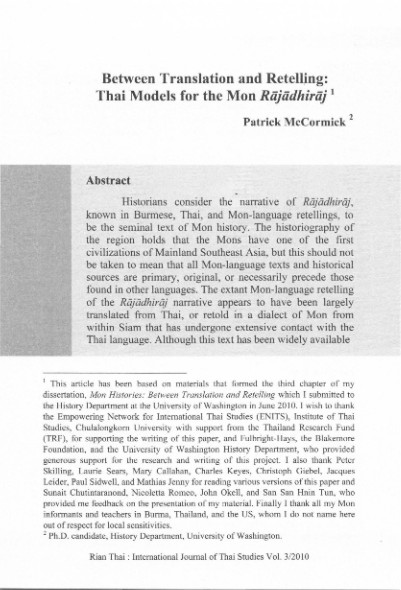Patrick McCormick
Abstract
Historians consider the narrative of Rajadhiraj, known in Burmese, Thai, and Man-language retellings, to be the seminal text of Mon history. The historiography of the region holds that the Mons have one of the first civilizations of Mainland Southeast Asia, but this should not be taken to mean that all Moo-language texts and historical sources are primary, original, or necessarily precede those found in other languages. The extant Man-language retelling of the Rajadhiraj narrative appears to have been largely translated from Thai, or retold in a dialect of Mon from within Siam that has undergone extensive contact with the Thai language. Although this text has been widely available in print for a hundred years, no scholars have commented on the unusual features of the language that the text is recorded in. Indeed, because of the assumption of Mon primacy, many scholars may not be able to conceive of the narrative as having come from outside Mon-language sources.
As part of a larger project of examining interpretative communities and frameworks, this article explores a specific example of how linguistic evidence may challenge the usual understandings and interpretations of Mainland Southeast Asian histories. A linguistic analysis of the text from the perspective of the scholarship on language contact and convergence reveals how native Mon words, phrases, and grammatical constructions have been reinterpreted to replicate Thai models. To gauge the language of this text, consider examples from contemporaneous texts produced inside Burma. Rather than searching for the original "version" or language of the narrative, I consider linguistic evidence to rethink how historical narratives may have been passed down to the present. The evidence suggests a heterogeneity of predecessors and modes of transmission.
(Published in Rian Thai: International Journal of Thai Studies, Volume 3/2010, Page 207-232)
Full Text : Download
